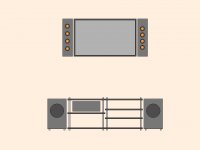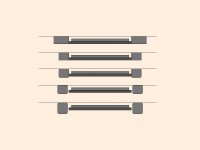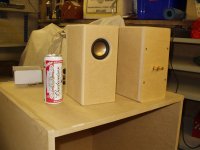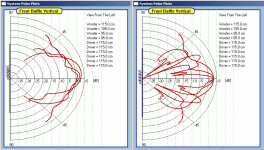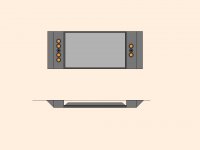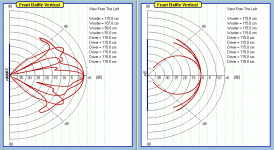I've got 20 HiVi B3S that I was about to sell-off in favour of the Tangband 871. Then I found this site http://www.zaphaudio.com/audio-speaker18.html which rates them above the tangband.
I was having trouble getting the tangband's to go low enough, but the HiVi's have no problem with 3mm xmax. I was worried by the HiVi freq response which falls off way below 20kHz, the in-box modelling shows it to be no worse than the Tangband though.
Anyway I plan to put 4 drivers each into 2 enclosures, and use my AVamp to crossover to 2 10" subs at 160Hz.
The enclosures will be tall and slim and wall mounted next to my TV like this:
I was having trouble getting the tangband's to go low enough, but the HiVi's have no problem with 3mm xmax. I was worried by the HiVi freq response which falls off way below 20kHz, the in-box modelling shows it to be no worse than the Tangband though.
Anyway I plan to put 4 drivers each into 2 enclosures, and use my AVamp to crossover to 2 10" subs at 160Hz.
The enclosures will be tall and slim and wall mounted next to my TV like this:
Attachments
So my questions are:
1. How to space the 4 drivers on the baffle?
The design is not sensitive to the volume of the enclosure, anything from 4litre to 20 litre will do.
2. So what width/depth do you recommend. Or how should I choose these?
3. How should I position and shape the baffle next to the screen? eg here are some layouts:
1. How to space the 4 drivers on the baffle?
The design is not sensitive to the volume of the enclosure, anything from 4litre to 20 litre will do.
2. So what width/depth do you recommend. Or how should I choose these?
3. How should I position and shape the baffle next to the screen? eg here are some layouts:
Attachments
hmmmm ... I was influenced by this design: http://www.seventh-veil.com/products_nonsuch4.htm
so is this idea fundamentally flawed then ?
so is this idea fundamentally flawed then ?
Greets!
Huh?! Effective CTC spacing is the primary issue in this case, not parallax error. I find the comb filtering unacceptable, but many don't, so if it works for ya'll, that's all that matters. Just looking at an FR plot though, a super tweeter seems the 'Hot Ticket', 'killing two birds with one stone'. A bit of fuzzy ambiance from comb filtering in music is one thing and quite another WRT TV/movie dialog intelligibility.
WRT positioning, you ideally want the focal point to be at 2/3 screen height and spaced apart/angled in at 60 deg included referenced to either the 'sweet spot' or the midpoint between rows, and until you in-wall mount them there's no such thing as too large a baffle IMO so I recommend spanning the gap between the speaker/TV with a baffle extension.
GM
Huh?! Effective CTC spacing is the primary issue in this case, not parallax error. I find the comb filtering unacceptable, but many don't, so if it works for ya'll, that's all that matters. Just looking at an FR plot though, a super tweeter seems the 'Hot Ticket', 'killing two birds with one stone'. A bit of fuzzy ambiance from comb filtering in music is one thing and quite another WRT TV/movie dialog intelligibility.
WRT positioning, you ideally want the focal point to be at 2/3 screen height and spaced apart/angled in at 60 deg included referenced to either the 'sweet spot' or the midpoint between rows, and until you in-wall mount them there's no such thing as too large a baffle IMO so I recommend spanning the gap between the speaker/TV with a baffle extension.
GM
Huh?! Effective CTC spacing is the primary issue in this case, not parallax error. I find the comb filtering unacceptable, but many don't, so if it works for ya'll, that's all that matters. Just looking at an FR plot though, a super tweeter seems the 'Hot Ticket', 'killing two birds with one stone'. A bit of fuzzy ambiance from comb filtering in music is one thing and quite another WRT TV/movie dialog intelligibility.
I didn't have much time, but a quick search pointed to comb filtering being about cancellation due to out of phase signals. The 2 sound waves will be out of phase by 1mm which is 1/17 wavelength at 20kHz, which results in 2% loss of amplitude. I don't think anyone claims that is perceivable (OK I'm sure someone will) but it's definitely not alarming.
If I've got the physics all wrong, could someone point me to the equations I need?
What was the size/spacing/distance away of the array you tried?
Jimbo, have you read Jim Griffin´s white paper?
http://www.audiodiycentral.com/awpapers.shtml
direct link to pdf : nflawp.pdf
looks like a good start
greets
http://www.audiodiycentral.com/awpapers.shtml
direct link to pdf : nflawp.pdf
looks like a good start
greets
You can solve the comb filtering problem by putting a 1st order lowpass on 3 out of the four drivers at say 1kHz. The 4th driver is the only one reproducing the high frequencies.
I'd also put a highpass on the 4th driver (the one acting as the "tweeter") at about 300Hz to relieve it of bass duty. The midrange clarity will improve and you'll actually increase the max spl that will sound good.
With the lowpass you have a lot of flexibility with driver placement. You can put them all in a straight line with the "tweeter" at the top, or second from the top, or you can cluster the other drivers around it.
If you have soundeasy, lspcad, or speaker workshop (free) try modeling a few different configurations and look at the polar response in the upper frequencies. You don't have to measure the drivers. Just input the correct diameter of the driver and model it as having a flat frequency response up to 20kHz.
P.S. Don't forget about baffle step correction if they aren't going to be flush against a wall.
I'd also put a highpass on the 4th driver (the one acting as the "tweeter") at about 300Hz to relieve it of bass duty. The midrange clarity will improve and you'll actually increase the max spl that will sound good.
With the lowpass you have a lot of flexibility with driver placement. You can put them all in a straight line with the "tweeter" at the top, or second from the top, or you can cluster the other drivers around it.
If you have soundeasy, lspcad, or speaker workshop (free) try modeling a few different configurations and look at the polar response in the upper frequencies. You don't have to measure the drivers. Just input the correct diameter of the driver and model it as having a flat frequency response up to 20kHz.
P.S. Don't forget about baffle step correction if they aren't going to be flush against a wall.
Ref Jim Griffin's paper
From figures 2,7,8 and from the text the 'comb line destructive interference' appears to be due to directivity not phase cancellation.
But seeing as there are no equations, just guidelines based on other peoples work, it's quite hard to tell.
If it is due to directivity, then the loss of response when you move off axis is no worse than for a single tweeter, the only difference is that the response comes back again when you move even further off axis.
Looks like I'll have to build and measure.
From figures 2,7,8 and from the text the 'comb line destructive interference' appears to be due to directivity not phase cancellation.
But seeing as there are no equations, just guidelines based on other peoples work, it's quite hard to tell.
If it is due to directivity, then the loss of response when you move off axis is no worse than for a single tweeter, the only difference is that the response comes back again when you move even further off axis.
Looks like I'll have to build and measure.
If you have soundeasy, lspcad, or speaker workshop (free) try modeling a few different configurations and look at the polar response in the upper frequencies. You don't have to measure the drivers. Just input the correct diameter of the driver and model it as having a flat frequency response up to 20kHz.
P.S. Don't forget about baffle step correction if they aren't going to be flush against a wall.
OK, looks like I will have to download some software and do some modelling.
I was hoping to avoid any filters.
Greets!
I've experimented with various tweeter, FR driver, midbass driver arrays (both flat and 'focussed') as well as auditioning all the arrays McIntosh produced. On axis the 'focussed' ones did quite well, but they had a very narrow 'sweet spot', and only the Mac XR290 truly 'worked'. When cost is no object, you could do a whole lot worse than these 'big boys' coupled to their electronics.
Anyway, yes, it's primarily a directivity issue, both on and off axis, so there's definitely some phase cancellation going on. Think about it, on axis you have four drivers 'shooting' progressively smaller 'balls' at you, so at some frequency they begin not summing sufficiently, then eventually reach the point where they can't possibly sum, so you're screwed even if you have your head locked in an 'optimum' position. Move your head and everything in the beaming BW shifts, so moving progressively further off axis really makes a mess of it.
Our hearing/on board computer system can extropate/EQ the mess quite a bit, but not enough, though folks with rolled off HF hearing and/or has some hearing damage down in our acute hearing BW don't seem to be bothered by it.
As always though, YMMV, so no need to measure or sim, just cobble together some prototypes and find out if their 'sound' works for you and at least a sampling of whoever is likely to be sharing the experience.
GM
I've experimented with various tweeter, FR driver, midbass driver arrays (both flat and 'focussed') as well as auditioning all the arrays McIntosh produced. On axis the 'focussed' ones did quite well, but they had a very narrow 'sweet spot', and only the Mac XR290 truly 'worked'. When cost is no object, you could do a whole lot worse than these 'big boys' coupled to their electronics.
Anyway, yes, it's primarily a directivity issue, both on and off axis, so there's definitely some phase cancellation going on. Think about it, on axis you have four drivers 'shooting' progressively smaller 'balls' at you, so at some frequency they begin not summing sufficiently, then eventually reach the point where they can't possibly sum, so you're screwed even if you have your head locked in an 'optimum' position. Move your head and everything in the beaming BW shifts, so moving progressively further off axis really makes a mess of it.
Our hearing/on board computer system can extropate/EQ the mess quite a bit, but not enough, though folks with rolled off HF hearing and/or has some hearing damage down in our acute hearing BW don't seem to be bothered by it.
As always though, YMMV, so no need to measure or sim, just cobble together some prototypes and find out if their 'sound' works for you and at least a sampling of whoever is likely to be sharing the experience.
GM
The two reasons I can think of to avoid filters is complexity and sound quality.
The benefit of cutting the high end out of 3 of the drivers is going to be much more flexibility on driver placement. A downside of not filtering is directivity vertical directivity. If you put them in a line you are going to have a very narrow sweet spot vertically. Like a 12" fullrange.
The sound quality benefit of cutting out the lows on one (or two) of the drivers is huge. It reduces intermodulation distortion that is very audible. This is going to be a much bigger plus than the penalty of any degradation you get from a single cap or inductor.
It won't be difficult to integrate identical widerange drivers with first order filters. Maybe you'll need an L-pad to match the sensitivity of the drivers. If I have some time this weekend I'll do some modeling in Soundeasy.
The benefit of cutting the high end out of 3 of the drivers is going to be much more flexibility on driver placement. A downside of not filtering is directivity vertical directivity. If you put them in a line you are going to have a very narrow sweet spot vertically. Like a 12" fullrange.
The sound quality benefit of cutting out the lows on one (or two) of the drivers is huge. It reduces intermodulation distortion that is very audible. This is going to be a much bigger plus than the penalty of any degradation you get from a single cap or inductor.
It won't be difficult to integrate identical widerange drivers with first order filters. Maybe you'll need an L-pad to match the sensitivity of the drivers. If I have some time this weekend I'll do some modeling in Soundeasy.
jimbo1968 said:hmmmm ... I was influenced by this design: http://www.seventh-veil.com/products_nonsuch4.htm
so is this idea fundamentally flawed then ?
Hi there.
No, the designs are not fundamentally flawed. They are, like all loudspeaker designs, a chosen compromise. The compromise with the Nonsuch 4 is that it's a 'sit-down loudspeaker'. The speaker is designed so that the centre of the drive units is at ear level and if the listener stays on this vertical axis within, say 15-20cm, there really isn't a problem. Stand up however and you lose some high frequencies. On the plus side, ceiling and floor reflections are significantly reduced so the speaker is less room-dependent than most.
I have experimented with crossovers and tweeters and, in my view, these cause a deterioration in sound quality, cohesion and 'naturalness'. Others, such as the great Ted Jordan, hold the same view. Many people who have heard the speakers concur and they were also well reviewed by Paul Messenger (who also knows a thing or two about speakers).
If you are going to go this route however, I recommend that you choose small drivers - Bandor 50s and Jordan JX53s are 50mm (2") diameter. Also, mount the drive units as close together as possible. I used special front plates which minimise the distance between drivers.
I hope that this clarifies.
Steve, I love the look of your Nonsuch4s.
£500 on drivers is a bit steep for a first project, that's why I bought a bunch of Hi-ViB3s to practice with, they are only slightly larger than the bandor50. If it turns out OK I might consider buying a set of Bandors. Although I might try to get a listen to your speaker's first.
Thanks for confirming that the drivers don't cancel each other out if you lift your head 40mm!
I've not bult the 4 driver speakers yet. Today I put together a pair of single driver speakers to practice my construction skills.
So here's a picture of my rear mounted drivers showing the 10mm roundover. Is that OK ? Is it worse than front mounting?
£500 on drivers is a bit steep for a first project, that's why I bought a bunch of Hi-ViB3s to practice with, they are only slightly larger than the bandor50. If it turns out OK I might consider buying a set of Bandors. Although I might try to get a listen to your speaker's first.
Thanks for confirming that the drivers don't cancel each other out if you lift your head 40mm!
I've not bult the 4 driver speakers yet. Today I put together a pair of single driver speakers to practice my construction skills.
So here's a picture of my rear mounted drivers showing the 10mm roundover. Is that OK ? Is it worse than front mounting?
Attachments
First the bad news and then some good news.
I did some modeling in Soundeasy and the results don't look good. Attached is an image with a comparison between a full-range design and one with a crossover. The two plots are of the the vertical axis at 2k, 4k, and 8k. The plot on the left is a configuration with one driver covering the HF alone and the others crossed over at about 3k 2nd order. The plot on the right is all four drivers running full range. It only gets worse at higher frequencies.
The drivers in the Nonsuch4 are spaced about half the distance apart center-to-center as the b3n drivers can be. It makes a big difference. Also the bandor drivers have a sweet top end. While Hi-vi's are down right fugly above 8k. Even the $5 dollar dayton tweeter Zaph is using in his latest project will blow away the b3n above 8k
The good news is that the b3n's are really nice wide-range drivers. High passed at 160Hz and paired with a tweeter above 4k they'll sound downright phenomenal. I'd put the tweeter in the center. It will look great.
To answer your original question, make the front of the speaker flush with the front of the TV. Place the side closer to the TV right up against it. The other side of the speaker I would build angled out as much as you can. 45 degrees would be good. This is to reduce diffraction at the edge of the speaker. Use a sander to round over the edge. The TV and the wall will act as a big front baffle.
I did some modeling in Soundeasy and the results don't look good. Attached is an image with a comparison between a full-range design and one with a crossover. The two plots are of the the vertical axis at 2k, 4k, and 8k. The plot on the left is a configuration with one driver covering the HF alone and the others crossed over at about 3k 2nd order. The plot on the right is all four drivers running full range. It only gets worse at higher frequencies.
The drivers in the Nonsuch4 are spaced about half the distance apart center-to-center as the b3n drivers can be. It makes a big difference. Also the bandor drivers have a sweet top end. While Hi-vi's are down right fugly above 8k. Even the $5 dollar dayton tweeter Zaph is using in his latest project will blow away the b3n above 8k
The good news is that the b3n's are really nice wide-range drivers. High passed at 160Hz and paired with a tweeter above 4k they'll sound downright phenomenal. I'd put the tweeter in the center. It will look great.
To answer your original question, make the front of the speaker flush with the front of the TV. Place the side closer to the TV right up against it. The other side of the speaker I would build angled out as much as you can. 45 degrees would be good. This is to reduce diffraction at the edge of the speaker. Use a sander to round over the edge. The TV and the wall will act as a big front baffle.
Attachments
Thanks JDY,
The b3s is only slight bigger than the bandor50. It can be spaced at 80mm centres. I don't suppose you could do me a plot with 80mm centres for comparison? And also a plot of the single driver?
I will still try 4 of them full range as they are on hand.
But I will also order a pair of tweeters. I may drop down to 2 b3s per side.
Just checking, is the attached what you described? I'm not sure about the looks, I think I'll build the triangles as removeable extensions and try with and without.
Now that the system needs a crossover that I don't have, I will have to get on and build my chipamps/ active crossovers.
The b3s is only slight bigger than the bandor50. It can be spaced at 80mm centres. I don't suppose you could do me a plot with 80mm centres for comparison? And also a plot of the single driver?
I will still try 4 of them full range as they are on hand.
But I will also order a pair of tweeters. I may drop down to 2 b3s per side.
Just checking, is the attached what you described? I'm not sure about the looks, I think I'll build the triangles as removeable extensions and try with and without.
Now that the system needs a crossover that I don't have, I will have to get on and build my chipamps/ active crossovers.
Attachments
Your picture looks good. Smart idea to make the triangles removable. The width of the box will be determined by how much internal volume you need. What tweeters are you looking at?
I can make those two plots for you this evening. How are you mounting the drivers so close? The spec says the frame is 90mm in diameter.
I don't think active crossovers will be worth the trouble in this case. You've got a lot of flexibility on the crossover because the b3n is a small driver and widerange. The crossover will be at a relatively high frequency >3k and doesn't have to be high order. That means there aren't too many parts and they are all small values.
I can make those two plots for you this evening. How are you mounting the drivers so close? The spec says the frame is 90mm in diameter.
I don't think active crossovers will be worth the trouble in this case. You've got a lot of flexibility on the crossover because the b3n is a small driver and widerange. The crossover will be at a relatively high frequency >3k and doesn't have to be high order. That means there aren't too many parts and they are all small values.
- Status
- This old topic is closed. If you want to reopen this topic, contact a moderator using the "Report Post" button.
- Home
- Loudspeakers
- Full Range
- Basic help with HiVi B3S design needed
